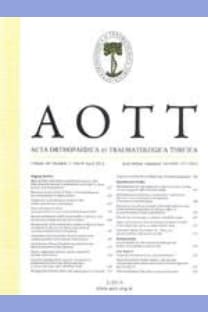Yirmi dört olguda ipsilateral ve tibia kırığı erişkinlerde "floating knee"
Kazalar, trafik, Kırık tespiti, internal, Diz yaralanmaları, Kırık tespiti, intramedüller, Femur kırıkları, Diz eklemi, Çoklu travma, Tibia kırıkları
The floating knee in adults. Twenty-four cases of ipsilateral fractures of the femur and the tibia
Accidents, Traffic, Fracture Fixation, Internal, Knee Injuries, Fracture Fixation, Intramedullary, Femoral Fractures, Knee Joint, Multiple Trauma, Tibial Fractures,
___
- 1.Blake R, McBryde A Jr. The floating knee: Ipsilateral fractures of the tibia and femur. South Med J 1975;68:13-6.
- 2. Karlstrom G, Olerud S. Ipsilateral fracture of the femur and tibia. J Bone Joint Surg [Am] 1977;59:240-3.
- 3.Veith RG, Winquist RA, Hansen ST Jr. Ipsilateral fractures of the femur and tibia. A report of fifty-seven consecutive cases. J Bone Joint Surg [Am] 1984;66:991-1002.
- 4.Theodoratos G, Papanikolaou A, Apergis E, Maris J. Simultaneous ipsilateral diaphyseal fractures of the femur and tibia: treatment and complications. Injury 2001;32: 313 -5 .
- 5.van Raay JJ, Raaymakers EL, Dupree HW. Knee ligament injuries combined with ipsilateral tibial and femoral diaphyseal fractures: the "floating knee". Arch Orthop Trauma Surg 1991;110:75-7.
- 6.Ostrum RF. Treatment of floating knee injuries through a single percutaneous approach. Clin Orthop 2000;(375):43-50.
- 7.Behr JT, Apel DM, Pinzur MS, Dobozi WR, Behr MJ. Flexible intramedullary nails for ipsilateral femoral and tibial fractures. J Trauma 1987;27:1354-7.
- 8.Anastopoulos G, Assimakopoulos A, Exarchou E, Pantazopoulos T. Ipsilateral fractures of the femur and tibia. Injury 1992;23:439-41.
- 9.Hung SH, Chen TB, Cheng YM, Cheng NJ, Lin SY. Concomitant fractures of the ipsilateral femur and tibia with intra-articular extension into the knee joint. J Trauma 2000; 48:547-51.
- 10.Hee HT, Wong HP, Low YP, Myers L. Predictors of outcome of floating knee injuries in adults: 89 patients followed for 2-12 years. Acta Orthop Scand 2001;72:385-94.
- 11.Letts M, Vincent N, Gouw G. The "floating knee" in children. J Bone Joint Surg [Br] 1986;68:442-6.
- 12.Baker SP, O'Neill B, Haddon W Jr, Long WB. The injury severity score: a method for describing patients with multiple injuries and evaluating emergency care. J Trauma 1974; 14:187-96.
- 13.Bohn WW, Durbin RA. Ipsilateral fractures of the femur and tibia in children and adolescents. J Bone Joint Surg [Am] 1991;73:429-39.
- 14.Bansal VP, Singhal V, Mam MK, Gill SS. The floating knee. 40 cases of ipsilateral fractures of the femur and the tibia. Int Orthop 1984;8:183-7.
- 15.Gregory P, DiCicco J, Karpik K, DiPasquale T, Herscovici D, Sanders R. Ipsilateral fractures of the femur and tibia: treatment with retrograde femoral nailing and unreamed tibial nailing. J Orthop Trauma 1996;10:309-16.
- ISSN: 1017-995X
- Yayın Aralığı: 6
- Başlangıç: 2015
- Yayıncı: Türk Ortopedi ve Travmatoloji Derneği
Asimetrik iki taraflı travmatik kalça çıkığı: Olgu sunumu
Murat Altay, Fırat YAĞMURLU, Memduh HEYBELİ, Hasan H. MURATLI, Yalçın TABAK, ALİ BİÇİMOĞLU
OSMAN TUĞRUL EREN, Metin KÜÇÜKKAYA, Mehmet TEZER, Cihat YILMAZ, Ünal KUZGUN
Dört olguda üç farklı yerleşim gösteren sinovyal kondromatozis
Nurzat ELMALI, İrfan ESENKAYA, Alpay ALKAN
Somatosensoriyal uyarılmış potansiyellerin torasik çıkış sendromu tanısında güvenilirliği
CENGİZ YILMAZ, İ. Kaan KAYAHAN, Sinan AVCI, Abtullah MİLCAN, Metin M. ESKANDARİ
Yirmi dört olguda ipsilateral ve tibia kırığı erişkinlerde "floating knee"
HÜSEYİN ARSLAN, Ahmet KAPUKAYA, Cumhur Cevdet KESEMENLİ, Serdar NECMİOĞLU, Mehmet SUBAŞI, Vafi ÇOBAN
Median sinirin kavernöz hemanjiomuna bağlı karpal tünel sondromu
Haluk H. ÖZTEKİN, Ahmet A. KARAARSLAN
Artroskopi yardımlı biseps tenodezi
Metin ÖZALAY, Sercan AKPINAR, Murat Ali HERSEKLİ, Gürkan ÖZKOÇ, Reha N. TANDOĞAN
Asetabulum kırıklarının cerrahi tadevisinde klinik ve radyolojik sonuçlar
Nurzat ELMALI, Kadir ERTEM, Muharrem İNAN, İRFAN AYAN, Yurdaer DENİZHAN
Gazi ZORER, A. Erdem BAGATUR, Ahmet DOĞAN, Tayyar ÜNLÜ
Açık redüksiyon ve internal fiksasyon uygulanan tibia pilon kırıklarında klinik sonuçlar
Önder KALENDERER, Osman GÜNEŞ, İ. Türkay ÖZÇALABI, Serkan ÖZLÜK
